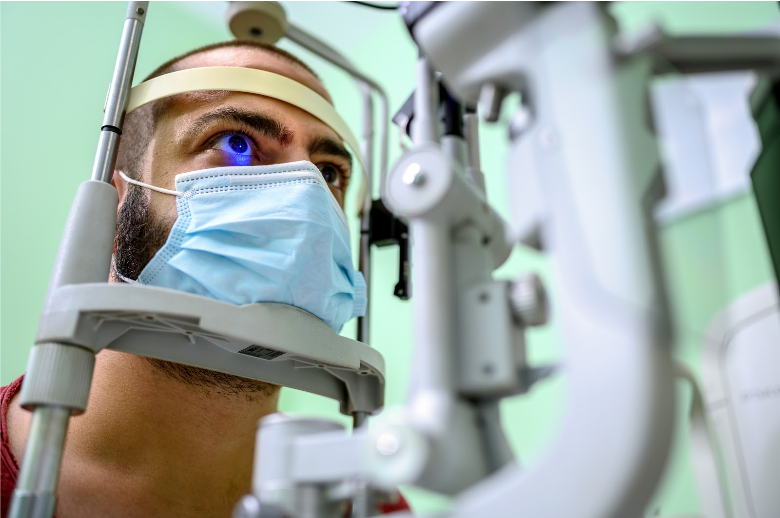
A year has passed since the COVID-19 pandemic changed everything about how people live, work, and receive medical care.
For ophthalmology and optometry practices across the country, it has been a year marked by both challenges and successes, and many businesses have emerged with new best practices that will continue to benefit patients, practitioners, and staff once the crisis has passed.
First and foremost, businesses had to be flexible in the face of change.
Soon after the first cases of the novel coronavirus emerged in 2020, widespread shutdown orders forced many practices to close their doors temporarily, during which time it became necessary to rethink how patient care would be provided amid an ongoing pandemic. Once practices were able to reopen, returning to "business as usual" was never an option.
Recently, Ophthalmology Times interviewed Peter J. Polack, MD, FACS and COO Zora Harrison of Ocala Eye in Ocala, Florida and asked them to share the steps they took to mitigate risk—in terms of both safety and revenue stream—while continuing to provide quality patient care during COVID-19.
Like many vision care offices that were able to successfully adapt to a new way of doing things, Dr. Polack said the key is to have resilience. "This won't be the last time we face an existential crisis like this," he stated, adding that, from the beginning, it was important for the team at Ocala Eye to try to keep things going as much as possible. This included making sure staff members stayed employed and focusing on things they could control rather than things they couldn't.
Creating a game plan helped to identify key goals.
The team at Ocala Eye began their planning process even before the government mandated they close their doors. They spent hours brainstorming ways to protect both their patients and their practice, focusing on two primary goals: 1.) ensuring patient and staff safety; and 2.) keeping their business running.
"We wanted our employees to know they were safe so they would come to work and help our patients," Harrison told Ophthalmology Times, noting that while some patients had the luxury of putting off routine eye exams, others, such as their retina, cornea, and glaucoma patients, still needed to come in.
The best strategies were not one-size-fits-all.
Among the strategies and initiatives implemented by the staff at Ocala Eye were an immediate rollout of telemedicine, which they handled in a unique way. Instead of offering just one option, they decided to search for all applications that were user friendly (e.g., docTV, EyecareLive, and Facebook calls) and give their patients the option of choosing which application worked best for their needs.
They also implemented a pre-screening protocol, which enabled staff to ask patient questions over the phone and reduced in-office time by 12 minutes on average. Further, they provided outdoor seating as well as properly spaced indoor seating, made it mandatory to wear a mask, and initiated temperature scanning for all patients.
In addition, they established a drive-up clinic where glaucoma patients could safely have their pressure checked. They also transitioned two of their nurse practitioners to triage, which not only made patients feel more comfortable but was a "billable benefit," said Harrison.
And finally, to maintain revenue, staff at Ocala Eye pulled reports of all of their patients who were using aesthetic or dry eye products and offered to do a mail order or provide their products via touch-free drive-up/pick-up. As such, they saw only a "very small dip in revenue" for that particular patient demographic.
What were some strategies that worked for other eye care professionals?
At the Eye Care Center of New York in Manhattan, a premium refractive practice founded by Dr. Tal Raviv, COVID-19 health and safety protocols had a dramatic impact on everyday patient care. However, Dr. Raviv says their practice was able to pivot successfully by offering innovative treatment options for chronic ocular conditions.
For example, they increased the use of in-office procedures such as intense pulsed light (IPL) and thermal pulsation, which improved patient outcomes and helped to reduce their reliance on monthly eye drops. It also helped to reduce patient costs.
For their glaucoma patients, the practice offered selective laser trabeculoplasty (SLT), and cataract or refractive lens exchange patients had the option of minimally invasive glaucoma surgery (MIGS). According to Dr. Raviv, "The combination of MIGS and refractive cataract surgery gives patients freedom from both medications and eyeglasses."
Administrative changes included switching to digital check-ins to eliminate paper forms, instituting contactless credit card payment, experimenting with directing incoming calls to an at-home staff member, and allowing patients to choose their level of in-office communication for surgical counseling.
What has helped your practice stay resilient during the pandemic?
Veatch is curious to know what policies and procedures your practice implemented to ensure staff and patient safety and maintain revenue during the COVID-19 crisis. How did these methods help to streamline workflow? And how easily did your team adapt to the changes? Comment below and we may feature your answers in a future blog.
Now through April 30, 2021
Get 0% financing on all purchases over $20K!
Call (855) 498-0854 for details